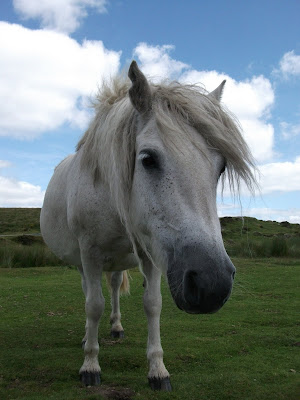The Dartmoor, without a doubt, has had a huge impact on our stay in Devon. We've explored it on foot, by car and bike, and still we experienced just a small part of it. We've been romanced by its history, lured and seduced by its landscape and wildlife.

The Dartmoor ponies, in particular, hold a special appeal for me, taking me back to my younger days (aged 10-12) when I fervently read every English-based 'Jill' pony book I could get my hands on. Now the lanes, the cottages, and countryside I once read about all become clear.
The Dartmoor ponies are an important part of the landscape. Archaeological digs found that descendants of these ponies roamed the moors around 3500 years ago. Today, ponies on the moor are likely to be a mix of 'native' Dartmoor and Shetland. They, along with 'Scotch' sheep and various breeds of cattle, help with conservation grazing, keeping the pastures and vegetation in check.

We are amazed at how placid these ponies are when it comes to tourists with cars and cameras. We even find some are very cheeky - pushing there muzzles in through open car windows, looking for a tidbit. We also learn that it is illegal to feed the ponies.
This is fine with Max as he shoos away a pony that tries to steal his lunch - just a little too close for his comfort.


Autumn has somehow sneaked up on us. When we first arrived in Ashburton, the evenings were drawn out - daylight until nearly 10pm (half past nine before the hens were ready to go to their cozy bed) and the days were warm. Now the evenings have closed in and the days are often wet and cold - darkness descending upon us by 8.30ish.
 It's our final few days of our homesit in Ashburton and this particular day we take in the last of the sun's rays by moving the outdoor chairs into the sun before it disappears over the hill.
It's our final few days of our homesit in Ashburton and this particular day we take in the last of the sun's rays by moving the outdoor chairs into the sun before it disappears over the hill.
It's late afternoon, we each have our novels, something to drink, cheese, olives, and a handful of Pringles chips, as we soak up the warmth. Then Max declares he'd like to go for a walk. Let's go up the Terrace path, I suggest, we could even take our books.
So off we go, books in hand and, of course two cameras. The Terrace path basks in sunlight as this little town slowly succumbs to the shadows. We find a bench seat luxuriating in the sun and make ourselves comfortable, leaning against each other for support.
It's a glorious spot, overlooking the outer parts of Ashburton, rolling hills and farmland. The late afternoon sun beats down on us warming our bodies and our hearts. A light breeze appears out of nowhere and plays with our books, pulling and tugging at the pages.
From below, we hear familiar sounds, all unseen: a rooster crows from the farm directly below us and then another replies from across the valley; children shout while at play in their backyards; a dog gives an intruder bark to a passerby; the clip clop of a horse's hooves as it trots along the lane; the see-saw drone of a lawnmower; a tractor as it chugs its way across a field; the raucous 'crawk' of the crows; the soft croon of the doves; and the gentle shushing sound of the breeze as it rushes through the trees nearby. All this, as the sun casts long, finger-like shadows across the green patchwork of pastures and the Dartmoor becomes a blue-grey silhouette against the sky.
It's been an amazing five weeks, living in another family's home and caring for their pets. We have had an insight into others' lives. Staying in a 300 year-old house is an experience, one where we learn to live with all its idosyncrasies and to appreciate its past. It's a good reminder that we are, afterall, just caretakers of these wonderful old buildings.
We have gained insight, too, into the lives of the little animals we have cared for and got to discover their individual characters and quirky natures.
But it is now time to move on. The next stage of our journey takes us to Scotland...
 |
| Low growing western gorse and heather make a beautiful and spectacular colour combination on the Dartmoor |

The Dartmoor ponies, in particular, hold a special appeal for me, taking me back to my younger days (aged 10-12) when I fervently read every English-based 'Jill' pony book I could get my hands on. Now the lanes, the cottages, and countryside I once read about all become clear.
The Dartmoor ponies are an important part of the landscape. Archaeological digs found that descendants of these ponies roamed the moors around 3500 years ago. Today, ponies on the moor are likely to be a mix of 'native' Dartmoor and Shetland. They, along with 'Scotch' sheep and various breeds of cattle, help with conservation grazing, keeping the pastures and vegetation in check.

We are amazed at how placid these ponies are when it comes to tourists with cars and cameras. We even find some are very cheeky - pushing there muzzles in through open car windows, looking for a tidbit. We also learn that it is illegal to feed the ponies.
This is fine with Max as he shoos away a pony that tries to steal his lunch - just a little too close for his comfort.
Below are some of the inhabitants of the moor...


Autumn has somehow sneaked up on us. When we first arrived in Ashburton, the evenings were drawn out - daylight until nearly 10pm (half past nine before the hens were ready to go to their cozy bed) and the days were warm. Now the evenings have closed in and the days are often wet and cold - darkness descending upon us by 8.30ish.
 It's our final few days of our homesit in Ashburton and this particular day we take in the last of the sun's rays by moving the outdoor chairs into the sun before it disappears over the hill.
It's our final few days of our homesit in Ashburton and this particular day we take in the last of the sun's rays by moving the outdoor chairs into the sun before it disappears over the hill.It's late afternoon, we each have our novels, something to drink, cheese, olives, and a handful of Pringles chips, as we soak up the warmth. Then Max declares he'd like to go for a walk. Let's go up the Terrace path, I suggest, we could even take our books.
So off we go, books in hand and, of course two cameras. The Terrace path basks in sunlight as this little town slowly succumbs to the shadows. We find a bench seat luxuriating in the sun and make ourselves comfortable, leaning against each other for support.
It's a glorious spot, overlooking the outer parts of Ashburton, rolling hills and farmland. The late afternoon sun beats down on us warming our bodies and our hearts. A light breeze appears out of nowhere and plays with our books, pulling and tugging at the pages.
From below, we hear familiar sounds, all unseen: a rooster crows from the farm directly below us and then another replies from across the valley; children shout while at play in their backyards; a dog gives an intruder bark to a passerby; the clip clop of a horse's hooves as it trots along the lane; the see-saw drone of a lawnmower; a tractor as it chugs its way across a field; the raucous 'crawk' of the crows; the soft croon of the doves; and the gentle shushing sound of the breeze as it rushes through the trees nearby. All this, as the sun casts long, finger-like shadows across the green patchwork of pastures and the Dartmoor becomes a blue-grey silhouette against the sky.
It's been an amazing five weeks, living in another family's home and caring for their pets. We have had an insight into others' lives. Staying in a 300 year-old house is an experience, one where we learn to live with all its idosyncrasies and to appreciate its past. It's a good reminder that we are, afterall, just caretakers of these wonderful old buildings.
We have gained insight, too, into the lives of the little animals we have cared for and got to discover their individual characters and quirky natures.
But it is now time to move on. The next stage of our journey takes us to Scotland...
 |
| It's just a little pony, Max... |











































